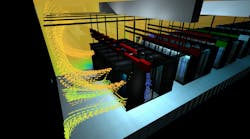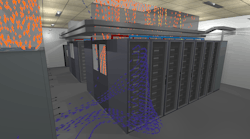New Partnerships Form to Deploy Digital Energy Twins in Data Centers
Key Highlights
- Digital twins—virtual models that mirror a physical data center's behavior and lifecycle before building the real system—allow operators to test new infrastructure, provide holistic management from design to decommissioning, and facilitate efficient energy management to meet surging demands.
- The trend of using digital twins in data centers, particularly for energy optimization, is expected to continue. Google and Microsoft are already using them, and giants like NVIDIA and Siemens are developing solutions.
- Eaton and Autodesk are collaborating to visualize and optimize energy systems for resilience using the Eaton Brightlayer Digital Energy Twin. Separately, Cadence has partnered with NVIDIA to incorporate a digital twin of the NVIDIA DGX SuperPOD into its platform to support AI buildout.
- Digital energy twins provide operators with design and planning, real-time supervision and anomaly detection, predictive maintenance, and safe system management and incident reconstruction without interrupting service.
- The next phase of digital twins is expected to feature deeper integration with AI, moving beyond monitoring and simulation to proactive, self-updating, and autonomous operations, enhancing predictive capabilities and driving greater efficiency and asset performance.
Digital twins can provide answers to questions data center builders and operators ask themselves, such as: How can we test new infrastructures without interrupting service? How can we manage the data center from the design phase to decommissioning? How can we meet our growing energy needs efficiently and cost effectively? These are important questions that are increasingly being answered with the help of digital energy twins.
The market for digital twins in data centers—especially for energy optimization—is experiencing rapid growth, with estimates projecting significant increases over the next decades. Leading companies such as Google and Microsoft already are using digital twins for energy optimization, and tech giants like NVIDIA and Siemens are developing solutions.
This month, power management company Eaton announced a significant collaboration with Autodesk, and electronic design automation company Cadence announced a major partnership with NVIDIA, both which bring digital energy twins to data centers to support power and energy resilience and AI buildout.
How Do Digital Twins Help Data Centers?
It’s important to understand what a digital twin is and how it works. A digital twin is a virtual model of a physical object, system, or process that mirrors its behavior and lifecycle of their real-world counterpart, allowing simulation and analysis before the real version is designed and built.
By providing a unified, real-time view of complex systems, digital twins can help data center teams optimize design, enhance control, maintain operating conditions, predict potential issues, and support scalability. This is achieved through features that include:
- Designing and planning to model the data center architecture before construction, evaluate location options, and plan for future needs.
- Providing early performance insights by gathering data on a system or object early in the design phase.
- Supporting continuous improvement by identifying which features work well and where changes are needed. This includes predictive maintenance using historical and real-time data to anticipate failures and plan for maintenance.
- Enabling safe system management and development without downtime. This includes incident management to virtually reconstruct critical events to analyze causes and test responses.
- Providing informed planning by assessing potential benefits of proposed changes and prioritizing tasks. For example, data centers can use digital twins to locate hot spots and confirm servers will be properly cooled; display status of servers, air conditioning units, and power supply hardware; monitor resource use; and detect anomalies.
- Performing compliance and audits to provide full configuration, operational, and change-management documentation to simplify regulatory compliance.
- Executing thermal and energy simulation to analyze thermal behavior, simulate air flows, and optimize cooling and energy consumption.
This last item—using digital twins for energy simulation—is driven by surging energy demand, the rise of AI and machine learning workloads, and increasing regulatory pressure for sustainability. So, the recent announcements from Eaton and Cadence are key advancements in this growing trend.
Eaton-Autodesk Collaboration Brings Energy System Visualization
The goal of Eaton’s collaboration with Autodesk is to improve building lifecycle management by advancing energy resilience and sustainability with enhanced speed, accuracy, and flexibility, according to Eaton representatives.
The alliance uses Eaton’s Brightlayer energy management and optimization solutions with Autodesk Tandem digital twin software to simplify complex energy system simulations and optimize electrical system performance across data centers and other structures. They’ve created the Eaton Brightlayer Digital Energy Twin, an AI-powered platform that integrates Eaton's Brightlayer energy software with Autodesk Tandem. It’s designed to provide facility designers, contractors, and operators with predictive insights into energy use and building performance.
Users can simulate and monitor how a facility will operate under varying conditions, evaluate the effects of potential infrastructure changes or upgrades before they’re implemented, and optimize energy efficiency and sustainability.
Autodesk Tandem has two primary features:
- Twin building, using a similar interface to other Autodesk software that AEC (Architect, Engineer & Construction) professionals can easily adapt to, and real-life insights.
- Real-life insights that let users see and understand the facility’s performance so they can make changes if needed.
Justin Carron, director of buildings and campuses at Eaton, claimed the tool’s capabilities “will fundamentally change how electrical systems are designed, built, and operated.” He said the digital twin’s differentiator is the combination of visualization with the predictive failure and maintenance features, which are designed to cut costs, speed up design, and increased efficiency.
The Eaton-Autodesk collaboration also introduced a new building information modeling (BIM) generation application for Autodesk Revit for design and engineering professionals to generate BIM files for electrical systems to simplify preconstruction planning.
But There’s More—Eaton Switchgear Power Quality Meter
In addition to the Autodesk partnership, Eaton announced a new edge-based solution to detect AI-driven power bursts. It’s available via a firmware update for its Eaton Power Xpert quality (PXQ) event analysis system, a power quality meter for switchgear, switchboards, and power distribution units (PDUs). Operators can identify potential subsynchronous oscillations (SSO) in data centers to protect infrastructure as AI energy demands accelerate.
AI data centers are experiencing “power bursting” — unseen spikes in energy usage caused by GPU servers powering AI workloads. SSO can damage both data center infrastructure and the grid, leading to issues such as transformer overheating, ferro resonant damage, and equipment damage.
The PXQ uses edge analytics to monitor and respond to power quality events such as sags, swells, transients, and harmonics. Operators can detect SSO and take preventive measures before they cause damage.
Cadence Expands Digital Twin Platform with NVIDIA
Cadence expanded its presence in the digital twin arena with a significant expansion of its Cadence Reality Digital Twin Platform library with a digital twin of NVIDIA DGX SuperPOD with DGX GB200 systems. The new model of NVIDIA’s high-performance accelerated computing platform is designed for data center designers and operators to easily deploy the AI accelerator in the buildout of AI factories.
With this expansion of the Cadence Reality Digital Twin Platform library, “designers can model behaviorally accurate simulations of some of the most powerful accelerated systems in the world, reducing design time and improving decision-making accuracy for mission-critical projects,” said Michael Jackson, senior vice president, System Design and Analysis at Cadence.
Jackson said the platform is “the first and only solution that lets users model AI factories and data centers with high accuracy to a specified service-level agreement—accounting for constraints such as cost, space, energy, cooling, and environmental impact—all before physical implementation.”
The platform lets designers drag and drop vendor-provided digital models, which function like their physical counterparts, into their data center digital twin. Engineers can design data centers and campuses to specified power, space, cooling, and performance requirements.
According to company representatives, users can quickly explore failure and upgrade scenarios. Once these data centers are up and running, this same Cadence Reality Digital Twin Platform can track and maintain optimal performance throughout their lifecycle.
Collaborations are the Norm
The addition of the NVIDIA DGX SuperPOD with DGX GB200 systems to the Cadence library is part of an ongoing collaboration between Cadence and NVIDIA. Last year, the two firms unveiled generative AI and accelerated compute-driven solutions, in which the Cadence Reality Digital Twin Platform integrated with the NVIDIA Omniverse and Orion molecular design platform accelerated with NVIDIA BioNeMo.
Earlier this year, the two companies announced the Cadence Reality Digital Twin Platform’s support of the NVIDIA Omniverse blueprint for AI factory design and operations.
In July, Eaton announced another collaboration with NVIDIA, this one to support the shift to high-voltage direct current (HVDC) power infrastructure in AI data centers. They’ll share design best practices, reference architectures, and power management solutions to support high-density GPU deployments, such as NVIDIA Kyber rack-scale systems with NVIDIA Rubin Ultra GPUs.
This includes helping with the transition to 800 volts HVDC power infrastructure to support 1-MW racks and exploring opportunities to use Eaton solutions in the NVIDIA Omniverse Blueprint for AI factory design and operations.
Eaton also is collaborating with global energy technology company Siemens Energy for a fast-track approach to building data centers with integrated onsite power. The goal is to provide reliable grid-independent energy supplies and standardized modular systems to facilitate swift data-center construction and deployment.
Of course, partnerships have been ongoing in the data center and AI realms. For example, Microsoft and AMD have a long-standing collaboration to provide powerful cloud solutions for enterprise workloads, high-performance computing, and AI. Google Cloud and NVIDIA have a deep partnership across the AI stack, allowing Google Cloud to integrate NVIDIA’s latest hardware and software into its services.
Colocation providers are collaborating with tech companies to offer turnkey AI solutions, while hardware, AI research labs, and cloud providers are joining forces in cross-industry alliances to support AI development.
What’s Next for Digital Energy Twins
Analysts anticipate that the next wave of digital energy twins will feature deeper integration with AI and the Internet of Things (IoT) for self-updating, autonomous operations, and enhanced predictive capabilities, moving beyond monitoring to proactive simulation and optimization.
Key developments include increased integration with quantum computing, the development of interoperable and standardized ecosystems, and a greater focus on cybersecurity to protect these complex systems. These advancements aim to drive greater operational efficiency, improve asset performance, reduce downtime, and support sustainability goals across the energy sector.
At Data Center Frontier, we talk the industry talk and walk the industry walk. In that spirit, DCF Staff members may occasionally use AI tools to assist with content. Elements of this article were created with help from OpenAI's GPT5.
Keep pace with the fast-moving world of data centers and cloud computing by connecting with Data Center Frontier on LinkedIn, following us on X/Twitter and Facebook, as well as on BlueSky, and signing up for our weekly newsletters using the form below.
About the Author

Theresa Houck
Senior Editor
Theresa Houck, Senior Editor, is an award-winning B2B journalist with 30+ years of experience. She writes about strategy, policy, and economic trends for EndeavorB2B on topics including data centers, cybersecurity, IT, OT, AI, manufacturing, industrial automation, energy, and more. With a master’s degree in communications from the University of Illinois Springfield, she previously served as Executive Editor for four magazines about sheet metal forming and fabricating at the Fabricators & Manufacturers Association, where she also oversaw circulation, marketing, and book publishing. Most recently, she was Executive Editor for the award-winning The Journal From Rockwell Automation custom publication on industrial automation where she also hosted and produced podcasts, videos and webinars; produced eHandbooks and newsletters; executed social media strategy; and more.





